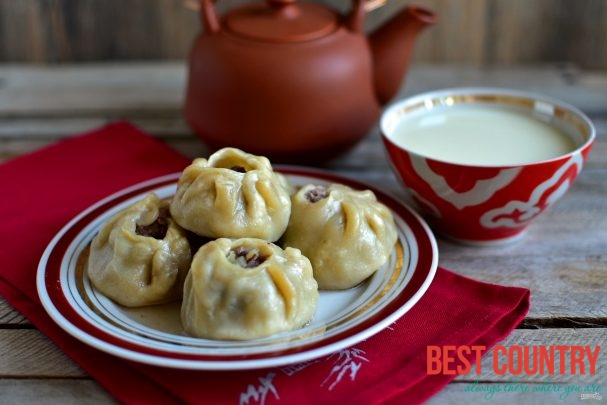The traditional Mongolian Cuisine primarily consists of dairy products and meat. The nomads of Mongolia sustain their lives directly from the products of their animals (horses, cattle, yaks, camels, sheep, and goats).
Cuisine of Mongolia
 Meat is either cooked, used as ingredient for soups or dumplings, or dried for winter ("Borts"). Milk and cream are used to make a variety of beverages, as well as cheese and similar products.
Meat is either cooked, used as ingredient for soups or dumplings, or dried for winter ("Borts"). Milk and cream are used to make a variety of beverages, as well as cheese and similar products.
The Mongolian diet includes a large proportion of animal fat. While this would lead to health problems in an industrialized society, it is necessary for the Mongols to withstand the cold winters and their hard work. Winter temperatures as low as -40 °C and outdoor work require sufficient energy reserves.
The nomads on the countryside are self-supporting by principle. Travellers will find yurts marked as "Guanz" in regular intervals near the roadside, which operate as simple restaurants.
Cooking in the yurt normally happens in a wok on a small stove, using wood or dried animal dung ("argal") as heating material.
Known dishes
The most common rural dish is cooked mutton, often without any other ingredients. In the city, every other locale displays a sign saying "buuz". Those are dumplings filled with meat, which are cooked in steam.
Other types of dumplings are boiled in water ("Bansh"), or deep fried in mutton fat ("Khuushuur"). Other dishes combine the meat with rice or fresh noodles into various stews (tsuivan, budaatai huurga) or soups (lapsha).
The most surprising cooking method is only used on special occasions. In this case, the meat (often together with vegetables) gets cooked with the help of stones, which have been preheated in a fire.
This either happens with chunks of mutton in a sealed milk can ("Khorkhog"), or within the stomach cavity of a deboned marmot or goat ("Boodog").
Milk is boiled to separate the cream ("Öröm" clotted cream). The remaining skimmed milk is processed into cheese ("Byaslag"), dried curds ("Aaruul"), yoghurt, kefir, as well as a light milk liquor ("Shimiin Arkhi"). The most prominent national beverage is airag, fermented mare's milk.
A popular cereal is barley, which is fried and malted. The resulting flour (arvain guril) is eaten as a porridge in milk fat and sugar or drunk mixed in milk tea. The everyday beverage is salted milk tea ("Süütei Tsai"), which may turn into a robust soup by adding rice, meat, or Bansh.
As a consequence of the Russian influence during socialism, vodka also has gained some popularity with a surprising number of local brands (usually grain spirits).
For dessert, Mongolians have boortsog, a type of Mongolian biscuit or cookie.
Hospitality
A guest entering a yurt will always be given something to eat. It is extremely rude to reject the offer, but it isn't necessary to empty the bowl either.
Taking a small bite or a sip satisfies the etiquette, and the rest may be returned without difficulty. An empty bowl will be refilled immediately. Food (as well as other items) are always passed and received with the right hand, while the left hand touches the right elbow for symbolic support.
Misunderstandings
Some restaurants in East Asia, Europe, and North America offer a type of cuisine called "Mongolian barbecue." Their staff will stir fry all kinds of ingredients (typically of East Asian origin) in front of the customer on a large heated steel or stone plate.
Although one such locale, BD's Mongolian Barbeque, has opened even in Ulaanbaatar (ironically the first American chain to open in Mongolia), neither the ingredients nor the cooking method has anything in common with Mongolian cuisine. Rather, they are inspired by the Japanese teppanyakiFact|date=May 2007.
Another deceptive meal is the "Mongolian Beef" sold in many Western restaurants. The narrowly sliced beef is stewed in a mixture of Eastern Asian flavour.
Mongolia is also often named as the region of origin for the hot pot, although with little scientific evidence. Both the preparation method and the required equipment are unknown in Mongolia today.
Especially the latter is much better suited for a sedentary culture. In a nomadic household, less specialized tools are preferred, to save volume and weight during migration.
Some sources claim that the old Mongols under Genghis Khan had placed pieces of meat under their saddles to tenderize them by the pressure, instead of cooking them—whence "steak tartare."
While they may indeed have sometimes placed meat under their saddles, whether they did do so for culinary reasons or to protect the back of their horses from getting chafed by the saddle is unknown.
The historical form of food for travel was the same back then as it is today, the dried and ground meat "Borts", dried curds and malted dry cereal cooked in milk.